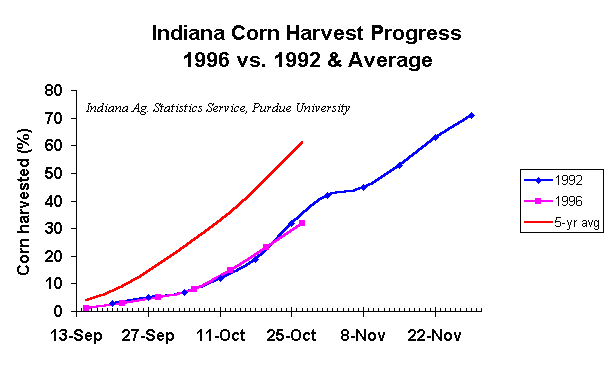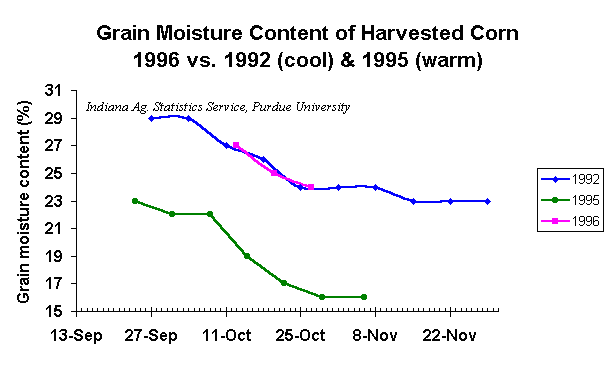
The current estimate of corn harvest progress in Indiana (Indiana Crop & Weather Report, 28 Oct 1996) continues to place the 1996 rate of harvest on par with the long, drawn-out progress we experienced in 1992 (Fig 1).

The average reported moisture content of the grain being harvested is also similar to those grain moisture contents experienced during harvest in 1992 (Fig. 2). Corn maturity in both years was later than normal and was coupled with cool fall temperatures that were not conducive to rapid grain moisture loss in the field.

It is important to remember that grain moisture loss in the field will be very slow from here on because of the continued normal decline in temperatures and usual onset of fall moisture patterns. Without above-normal temperatures and/or dry sunny conditions, the rate of grain drying in the field will probably not exceed 1/4 percentage point of moisture per day (equal to one point of moisture every four days) from early to mid-November.
The bottom line is that Indiana corn growers in 1996 do not have the luxury of allowing corn to dry to the low 20's before harvest, especially much of the June-planted corn. Some may be lucky if the grain dries to the high 20's before the snow flies. Be prepared to harvest as soon as you can do so without excessive damage to the grain. Also, be prepared for the bottleneck of mechanical drying.
The potential savings in drying costs by leaving the corn to dry naturally in the field can easily be outweighed by potential yield losses in the field due to stalk breakage (stalk rot or European corn borer damage), ear droppage (European corn borer damage), or ear rots. If the weather would happen to take a turn for the worse (stormy, wet, cool), the potential for field losses would increase dramatically.
 Return to the the
Chat 'n Chew Cafe.
Return to the the
Chat 'n Chew Cafe.
 The Corn Growers Guidebook , a WWW resource
for corn management systems in Indiana and the eastern CornBelt.
The Corn Growers Guidebook , a WWW resource
for corn management systems in Indiana and the eastern CornBelt.
 Purdue University Agronomy Extension WWW
Home Page.
Purdue University Agronomy Extension WWW
Home Page.
 Purdue Agronomy On-Line! , Purdue's Agronomy
Department WWW Home Page.
Purdue Agronomy On-Line! , Purdue's Agronomy
Department WWW Home Page.